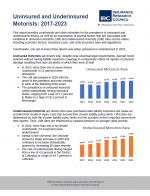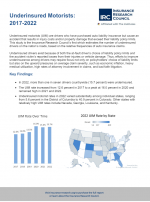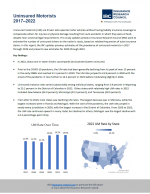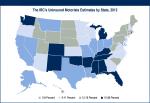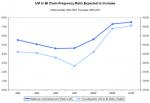Research Publications
Uninsured and Underinsured Motorists: 2017-2023
This report provides countrywide and state estimates for the prevalence of uninsured and underinsured driving, as well as an examination of several factors that are associated with variations in uninsured motorists (UM) and underinsured motorists (UIM) rates across states, including economic factors, insurance costs, and state insurance laws and regulations.
Report Summary:
Underinsured Motorists, 2017-2022
In this report, the IRC expands the line of uninsured motorists research and provides estimates for the rate of underinsured motorists (UIM), countrywide and in every state. Underinsured motorists are drivers who have purchased auto liability insurance but cause an accident that results in injury costs and/or property damage that exceed their liability policy limits.
Report Summary:
Uninsured Motorists, 2017-2022
Uninsured motorists (UM) are drivers who operate motor vehicles without having liability insurance coverage to compensate others for injuries or physical damage resulting from auto accidents in which they were at fault, despite near-universal legal requirements. This study, which updates previous Insurance Research Council (IRC) research, estimates the number of uninsured drivers on the nation’s roads, based on relative frequencies of auto insurance claims.
Report Summary:
Uninsured Motorists, 2021 Edition
This study examines trends in the percentage of uninsured motorists in each state based on uninsured motorists and bodily injury claim frequencies from 2015 through 2019. This report includes previous estimates beginning in 1999.
Uninsured Motorists, 2017 Edition
This study examines trends in the percentage of uninsured motorists by state and countrywide. This edition of the report updates trends with new data for the period 2013-2015.
Uninsured Motorists, 2014 Edition
This study examines trends in the percentage of uninsured motorists by state utilizing uninsured motorists and bodily injury claim frequencies from 2010-2012. The report also produces quantitative estimates by state and over time for the amount of uninsured motorists and total uninsured motorist claim payments.
The Potential Effects of No Pay, No Play Laws
This study seeks to measure the impact of no pay, no play laws on the percentage of uninsured motorists. It also estimates the costs of
noneconomic damages awarded to uninsured motorists in states that have yet to enact such laws. The findings suggest that not only
would a properly enforced no pay, no play law result in a moderate decrease in uninsured motorists, it may also reduce auto insurance
costs.
Uninsured Motorists, 2011 Edition
Across the United States, chances are roughly one in seven that a driver is uninsured, according to new estimates from the Insurance Research Council (IRC). The estimated percentage of uninsured motorists declined four straight years before rising to 14.3 percent in 2008 and dropping to 13.8 percent in 2009. The economic downturn is thought to be a major factor in the brief increase.
Uninsured Motorists - 2008 Edition
Approximately one in six drivers across the United States may be driving uninsured by 2010, according to a recent study from Insurance Research Council (IRC). Although the estimated percentage of uninsured motorists decreased nationally, from 14.9 percent in 2003 to 13.8 percent in 2007, the recent economic downturn is expected to trigger a sharp rise in the uninsured motorist rate. The recently released study, Uninsured Motorists, 2008 Edition, estimates the percentage of uninsured drivers countrywide and by state for the period 2005 to 2007. The IRC estimates the uninsured driver population using a ratio of insurance claims made by individuals who were injured by uninsured drivers to claims made by individuals who were injured by insured drivers. The study contains recent statistics by state on uninsured motorists claim frequency, bodily injury liability claim frequency, and the ratio of uninsured motorists to bodily injury claim frequencies.
Uninsured Motorists 2006
This study examines trends in the percentage of uninsured motorists in each state based on uninsured motorists and bodily injury claim frequencies from 1999 to 2004. City-level data were also analyzed in six states.
- Purchase PDF ()
- Purchase Printed ()
- View News Release

